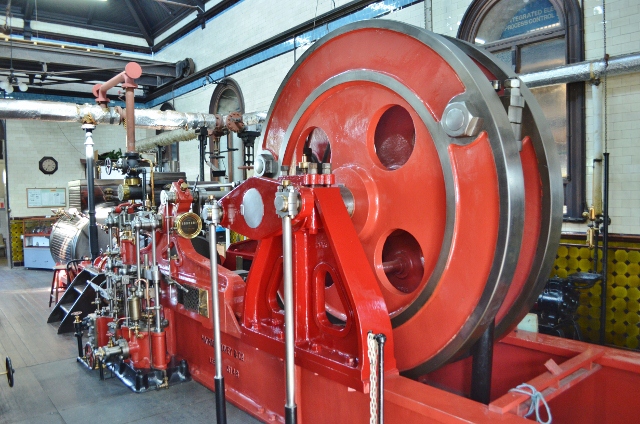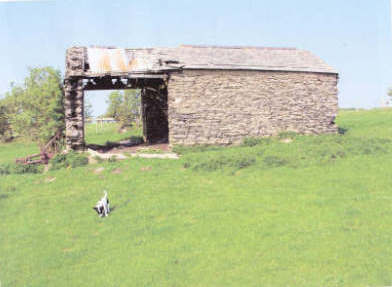|
Hathorn Davey
Hathorn Davey was a British manufacturer of steam engines, based in Leeds. The Sun foundry was established in 1846 and made railway engines and pumping machinery until 1870. The premises were taken over in 1872 by Hugh Campbel, Alfred Davis and John Hathorn. They were joined by Henry Davey in 1873 and traded as Hathorn, Davey & Co from 1880. The partnership was converted to a limited company in 1901. They made marine engines and pumps as well as their pumping engines for mines and waterworks. The pumping engine built for the Mersey tunnel in 1881 was described at the time as the most powerful in existence. The firm was taken over by Sulzer (manufacturer), Sulzers in 1936. The premises closed in late 1981 when Sulzers moved to a new site. The horizontal compound differential pumping engine This was one of their more successful engines. Patented in 1871, a company brochure lists 46 examples of these large engines built up to 1906. The leaflet also gives 32 examples where a small ... [...More Info...] [...Related Items...] OR: [Wikipedia] [Google] [Baidu] |
Hathorn Davey 1894 Pumping Engine-geograph-3090561-by-Ashley-Dace
Hathorn is a surname. Notable people with the surname include: *David Hathorn (born 1962), South African businessman *Gina Hathorn (born 1946), British alpine skier *Henry H. Hathorn (1813–1887), American politician *John Hathorn (1749–1825), American politician *Libby Hathorn, Australian writer *Linda Hathorn (born 1982), Canadian women's soccer player *Maitland Hathorn (1878–1920), South African cricketer See also *Hathorn Hall, academic building at Bates College in Lewiston, Maine, United States *Hathorne {{surname, Hathorn ... [...More Info...] [...Related Items...] OR: [Wikipedia] [Google] [Baidu] |
Leeds
Leeds () is a city and the administrative centre of the City of Leeds district in West Yorkshire, England. It is built around the River Aire and is in the eastern foothills of the Pennines. It is also the third-largest settlement (by population) in England, after London and Birmingham. The city was a small manorial borough in the 13th century and a market town in the 16th century. It expanded by becoming a major production centre, including of carbonated water where it was invented in the 1760s, and trading centre (mainly with wool) for the 17th and 18th centuries. It was a major mill town during the Industrial Revolution. It was also known for its flax industry, iron foundries, engineering and printing, as well as shopping, with several surviving Victorian era arcades, such as Kirkgate Market. City status was awarded in 1893, a populous urban centre formed in the following century which absorbed surrounding villages and overtook the nearby York population. It is locate ... [...More Info...] [...Related Items...] OR: [Wikipedia] [Google] [Baidu] |
Sulzer (manufacturer)
Sulzer Ltd. is a Swiss industrial engineering and manufacturing firm, founded by Salomon Sulzer-Bernet in 1775 and established as Sulzer Brothers Ltd. (Gebrüder Sulzer) in 1834 in Winterthur, Switzerland. Today it is a publicly traded company with about 180 manufacturing facilities and service centers around the world. The company's shares are listed on the Swiss Stock Exchange. Sulzer is a global leader in fluid engineering. The company specializes in pumping, agitation, mixing, separation and purification technologies for fluids of all types. Sulzer provides new equipment for large infrastructure across various markets, among others water and wastewater, energy, chemicals, renewables and industrial processes. The service business makes up half of the company's sales. A growing part of the business are renewable applications such as biopolymers, recycling and low-carbon solutions. In its almost 200-year history, the company has gained international recognition with invention ... [...More Info...] [...Related Items...] OR: [Wikipedia] [Google] [Baidu] |
Miike Coal Mine
, also known as the , was the largest coal mine in Japan,Karan, P.P. & Stapleton, K.E. (1997) ''The Japanese city'p.181University Press of Kentucky Retrieved January 2012. located in the area of Ōmuta, Fukuoka and Arao, Kumamoto, Japan. In 1960, it was the setting for the "Miike Struggle," which was the largest management-labor dispute in Japanese history. History Mining began in the region during the Kyoho era, with the Miike mine under the control of the Tachibana clan. The mine was nationalised in 1872Industrial pollution in Japan Chapter - 5 The Miike coal-mine explosion by the . The |
Yawata Steel Works
The is a steel mill in Kitakyūshū, Fukuoka Prefecture, Japan. Imperial Steel Works was established in 1896 to meet increasing demand from the nation's burgeoning shipbuilding, railway, construction, and armaments industries. The site chosen was the former town of Yahata, now merged into Kitakyūshū, near coal mines and with easy access to the sea. History With the opening of Japan, Western-style reverberatory furnaces had been introduced in a number of areas to replace the native tatara system. In the early Meiji period, blast furnaces were constructed at sites such as Kamaishi in Iwate Prefecture, near deposits of iron. The Higashida First Blast Furnace, designed and tooled by German engineering firm Gute Hoffnungshütte, began operations at Yahata on 5 February 1901. The low quality of output, high ratio of coke consumption to steel produced, and a number of failures led to suspension the following year; all but one of the German advisers were dismissed and the ... [...More Info...] [...Related Items...] OR: [Wikipedia] [Google] [Baidu] |
Beaconsfield
Beaconsfield ( ) is a market town and civil parish within the unitary authority of Buckinghamshire, England, west-northwest of central London and south-southeast of Aylesbury. Three other towns are within : Gerrards Cross, Amersham and High Wycombe. The town is adjacent to the Chiltern Hills Area of Outstanding Natural Beauty and has a wide area of Georgian, neo-Georgian and Tudor revival high street architecture, known as the Old Town. It is known for the first model village in the world and the National Film and Television School. Beaconsfield was named 'Britain's richest town' (based on an average house price of £684,474) by ''The Daily Telegraph'' in 2008. In 2011 the post town had the highest proportion in the UK of £1 million-plus homes for sale (at 47%, compared to 3.5% nationally). In 2011, Burkes Road was named as the second most expensive road in the country outside London. History and description The parish comprises Beaconsfield town and land mainly given o ... [...More Info...] [...Related Items...] OR: [Wikipedia] [Google] [Baidu] |
Harrison Ainslie
The firm of Harrison Ainslie & Co. was a British firm of ironmasters and iron ore merchants, selling high quality haematite from their mines on Lindal Moor to smelters in Glasgow, Scotland, South Wales and the Midlands. From a 21st-century perspective, they are more interesting as the last operators of charcoal-fired blast furnaces in Great Britain. Their furnaces were stone-built, water-powered, and much smaller than the coke-fired furnaces of the same era. Managers At various times the company was known as Richard Ford & Co, the Newland Co, George Knott & Co, Knott, Ainslie & Co, Harrison Ainslie & Co, Harrison Ainslie, Roper & Co, and finally as Harrison Ainslie & Co Ltd. Associated companies were the Hampshire Haematite Iron Co, Melfort Gunpowder Co, Lorn Furnace Co and Barrow & Ulverston Rope Co. Newland Furnace was built in 1747 by Richard Ford, William Ford, Michael Knott and James Backhouse. Richard Ford was born in Middlewich in 1697. He was active in the Furness ir ... [...More Info...] [...Related Items...] OR: [Wikipedia] [Google] [Baidu] |
Cambridge Museum Of Technology
The Cambridge Museum of Technology is an industrial heritage museum situated in Cambridge, England. The original building, a Scheduled Ancient Monument, housed a combined sewage pumping and waste destructor station built in 1894. The Museum helps people to explore, enjoy, and learn about their industrial heritage by celebrating the achievements of local industries and the people who worked in them. The large site on the River Cam has green spaces for picnics and a fun, relaxed atmosphere for families. There are audio-visual displays, hands-on exhibits, and children’s activities, as well as traditional museum displays and historic buildings. The Victorian Pumping Station with its original machinery showcases 19th-century engineering and technology. Displays on the forgotten industries of Cambridge reveal an alternative side of the city’s history to the famous colleges. And the story is brought into the 20th Century with exhibitions on innovative local companies in our new Py ... [...More Info...] [...Related Items...] OR: [Wikipedia] [Google] [Baidu] |
Yarlside 003
Yarlside is a hill in the Howgill Fells, Cumbria (historically Westmorland), England. This fell is not to be confused with the Yarlside area near Barrow-in-Furness, once served by the Yarlside Iron Mines tramway. That lies to the west. Nor should it be confused with Great Yarlside and Little Yarlside on the eastern fringes of the Lake District The Lake District, also known as the Lakes or Lakeland, is a mountainous region in North West England. A popular holiday destination, it is famous for its lakes, forests, and mountains (or ''fells''), and its associations with William Wordswor ..., to the northwest. Peaks of the Yorkshire Dales Marilyns of England Hewitts of England Nuttalls Ravenstonedale {{Cumbria-geo-stub ... [...More Info...] [...Related Items...] OR: [Wikipedia] [Google] [Baidu] |
Steam Engine Manufacturers
Steam is a substance containing water in the gas phase, and sometimes also an aerosol of liquid water droplets, or air. This may occur due to evaporation or due to boiling, where heat is applied until water reaches the enthalpy of vaporization. Steam that is saturated or superheated is invisible; however, "steam" often refers to wet steam, the visible mist or aerosol of water droplets formed as water vapor condenses. Water increases in volume by 1,700 times at standard temperature and pressure; this change in volume can be converted into mechanical work by steam engines such as reciprocating piston type engines and steam turbines, which are a sub-group of steam engines. Piston type steam engines played a central role in the Industrial Revolution and modern steam turbines are used to generate more than 80% of the world's electricity. If liquid water comes in contact with a very hot surface or depressurizes quickly below its vapor pressure, it can create a steam explosion. Types ... [...More Info...] [...Related Items...] OR: [Wikipedia] [Google] [Baidu] |
Manufacturing Companies Based In Leeds
Manufacturing is the creation or production of goods with the help of equipment, labor, machines, tools, and chemical or biological processing or formulation. It is the essence of secondary sector of the economy. The term may refer to a range of human activity, from handicraft to high-tech, but it is most commonly applied to industrial design, in which raw materials from the primary sector are transformed into finished goods on a large scale. Such goods may be sold to other manufacturers for the production of other more complex products (such as aircraft, household appliances, furniture, sports equipment or automobiles), or distributed via the tertiary industry to end users and consumers (usually through wholesalers, who in turn sell to retailers, who then sell them to individual customers). Manufacturing engineering is the field of engineering that designs and optimizes the manufacturing process, or the steps through which raw materials are transformed into a final product. T ... [...More Info...] [...Related Items...] OR: [Wikipedia] [Google] [Baidu] |

.jpg)




